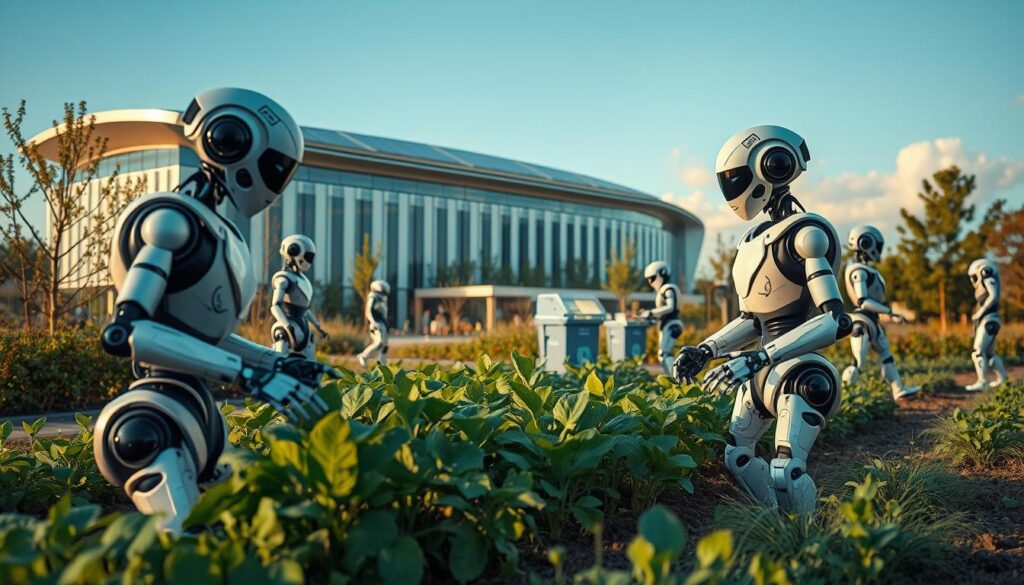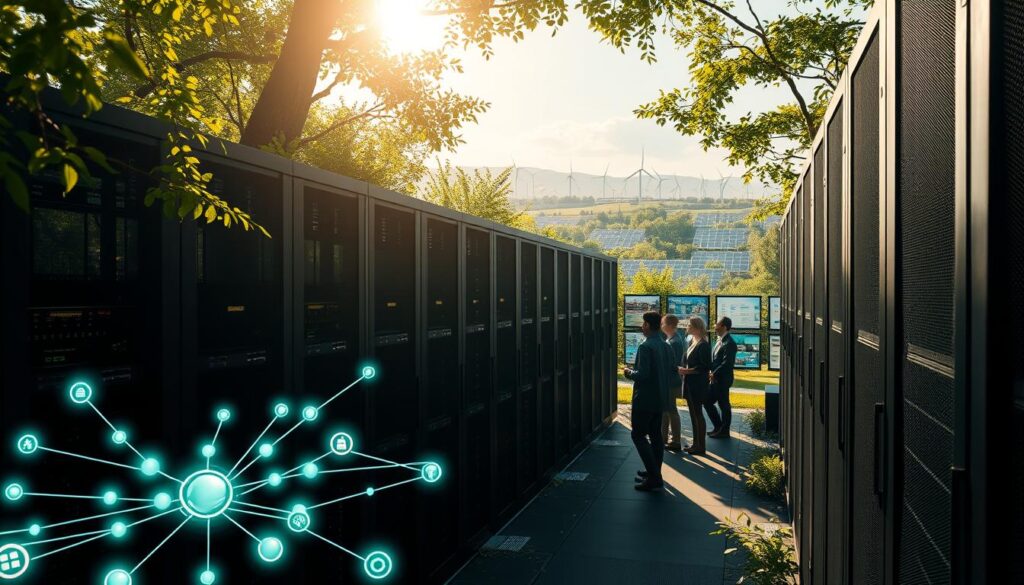“We cannot solve our problems with the same thinking we used when we created them,” said Albert Einstein. This quote resonates deeply as innovative technologies reshape how businesses approach sustainability. AI agents are at the center of this transformation, automating complex tasks and driving efficiency in ways previously unimaginable.
These agents process vast amounts of data, enabling rapid compliance with regulations like the Corporate Sustainability Reporting Directive (CSRD)1. By analyzing product development and supply chains, they significantly reduce Global Warming Potential (GWP)1. This technology is not just a tool; it’s a solution for businesses aiming to balance innovation with environmental impact.
From optimizing energy use to enhancing data accuracy, AI agents are redefining sustainability. This article explores how these technologies are shaping a greener future, one data point at a time.
Key Takeaways
- AI agents automate complex tasks, improving efficiency in sustainability efforts.
- They enhance data accuracy, supporting better decision-making for businesses.
- These technologies reduce carbon footprints through advanced analytics.
- AI helps achieve compliance with environmental regulations like CSRD.
- They are a key solution for balancing innovation and environmental impact.
Introduction: Exploring the Intersection of AI and Sustainability

As climate challenges grow, innovative solutions are reshaping how industries approach sustainability. Businesses and governments are prioritizing strategies that balance growth with environmental responsibility. This shift is driven by urgent issues like resource scarcity and rising global temperatures2.
Evolving environmental demands are pushing industries to adopt smarter practices. For example, the manufacturing sector, known for its heavy water and energy consumption, is leveraging technology to reduce its carbon footprint2. These changes are not just about compliance; they’re about creating a lasting impact.
Setting the Stage for Environmental Change
Climate change is no longer a distant threat; it’s a present reality. Organizations are recognizing the need to act now. The United Nations’ 17 Sustainable Development Goals (SDGs) highlight the urgency of addressing global challenges by 20302.
Innovative technologies are playing a key role in this transformation. For instance, smart grids use advanced algorithms to predict energy demand, reducing waste and enhancing efficiency2. These solutions are setting the stage for a more sustainable future.
The Emergence of AI in Sustainable Practices
AI is emerging as a powerful tool in the fight against climate change. From optimizing energy use to improving recycling processes, it’s driving efficiency across industries. For example, recycling robots can sort materials faster than humans, significantly improving waste management2.
Businesses are also investing in high-quality datasets to accelerate their sustainability initiatives. According to a Gartner survey, 87% of leaders plan to increase their sustainability investments in the coming years3. This focus on data and technology is shaping a greener, more resilient future.
For more insights on how technology is transforming business practices, visit this detailed guide.
Understanding The Role of AI Agents in Environmental Sustainability Initiatives

Advanced technologies are reshaping how industries tackle environmental challenges. These tools are not just about automation; they’re about creating smarter, more efficient systems. By leveraging data and sophisticated models, organizations can address sustainability goals effectively.
Defining AI Agents and Their Core Capabilities
AI agents are specialized tools designed to perform complex tasks autonomously. Unlike traditional chatbots, they process vast amounts of datum to make informed decisions. For example, they optimize energy use in buildings, reducing waste by up to 20%4.
These agents excel in analyzing patterns and predicting outcomes. They can enhance recycling rates by 30% through automated sorting processes5. This capability makes them invaluable for organizations aiming to reduce their environmental impact.
Agentic Systems and Workflow Patterns
Agentic systems involve networks of AI agents working together to achieve specific goals. They use workflows like iterative reflection and task subdivision to improve efficiency. For instance, smart grids employ these systems to predict energy demand, reducing peak load by 15-25%4.
These systems are particularly effective in industries like agriculture. Precision farming techniques, powered by AI, can reduce water usage by up to 50%5. Such innovations highlight the transformative potential of agentic workflows.
Differentiating AI Agents from Conventional Chatbots
While chatbots handle simple queries, AI agents perform multifaceted roles. They analyze data, make decisions, and execute tasks autonomously. For example, they optimize waste disposal routes, cutting operational costs by 25%5.
Companies are increasingly adopting these technologies to meet sustainability challenges. By integrating AI with IoT devices, they can improve operational efficiency by up to 40%4. This layered complexity sets AI agents apart from simpler chatbot technologies.
Implementing Agentic Workflows for Data-Driven Sustainability

Agentic workflows are transforming how businesses handle sustainability challenges. These systems automate complex tasks, reducing manual processing and errors. By leveraging advanced tools, organizations can achieve higher efficiency and accuracy in their operations6.
Automating Complex Environmental Tasks
Agentic workflows excel in automating tasks like data ingestion and validation. For example, they can analyze carbon footprints and energy consumption, providing tailored recommendations6. This reduces manual effort and improves decision-making quality.
Specialized tools, such as web search and code execution modules, expand the capabilities of these workflows. They enable organizations to process vast amounts of information quickly and accurately7.
Leveraging External Tools and Integrated Databases
Integrating external databases ensures that responses are grounded in accurate information. This approach enhances the quality of sustainability reports and compliance efforts6.
For instance, optimized storage solutions like Amazon S3’s intelligent tiering can cut energy use by up to 70%8. Such innovations streamline processes and reduce environmental impact.
By adopting these tools, businesses can achieve significant energy savings and operational efficiency. This makes agentic workflows a key solution for sustainable practices.
Integrating AI with Sustainability Data and Regulatory Compliance
Organizations are leveraging advanced tools to meet regulatory demands effectively. Compliance with sustainability regulations, such as the Corporate Sustainability Reporting Directive (CSRD), requires precise datum management and timely reporting. Advanced systems automate these processes, ensuring accuracy and efficiency9.
These tools expedite compliance workflows by automating tasks like emission tracking and reporting. For instance, Google DeepMind’s project achieved a 40% reduction in energy consumption through advanced algorithms10. Such innovations highlight the transformative potential of integrating technology with regulatory requirements.
Navigating CSRD and Environmental Regulations
Automating datum validation and reconciliation is crucial for compliance. AI-powered systems analyze vast amounts of information, identifying trends and anomalies in emissions data11. This ensures organizations adhere to evolving regulations while reducing their carbon footprints.
Case studies demonstrate the impact of these tools. For example, AI-driven solutions in public spaces optimize energy use by analyzing foot traffic patterns10. These applications not only enhance compliance but also promote sustainable practices across industries.
Integrating advanced technologies with robust policy frameworks offers significant benefits. Organizations can achieve operational efficiency, reduce costs, and attract investment by demonstrating compliance with ESG criteria11. This combination of innovation and regulation is shaping a greener future.
Practical Steps to Develop and Scale AI for Sustainable Business
Sustainable practices are becoming a priority for forward-thinking enterprises. Integrating advanced systems requires a structured approach, from discovery to full-scale implementation. This phased strategy ensures that businesses can effectively address environmental challenges while maintaining operational efficiency.
Discovery and Collaboration with Stakeholders
The first step is identifying critical processes that can benefit from technology. Companies must engage key stakeholders, including employees, partners, and regulators, to gather valuable information. This collaborative effort ensures that solutions align with organizational goals and sustainability targets12.
For example, enterprises can use workshops and surveys to understand specific needs. This approach helps in designing systems that address real-world challenges effectively13.
Design & Prototype for Agentic Systems
Once needs are identified, the next step is designing and prototyping. Using real operational datum, businesses can test systems in simulated scenarios. This iterative process allows for refining solutions before full deployment12.
Prototyping also helps in identifying potential issues early. For instance, a company might discover energy inefficiencies during testing, enabling timely adjustments13.
Implementation and Scaling Solutions in Practice
Scaling solutions requires careful planning to ensure cost-effectiveness. Businesses should start with pilot projects, gradually expanding to enterprise-level applications. This phased approach minimizes risks and maximizes impact12.
Expert insights highlight the importance of ongoing effort in adopting innovative practices. For example, integrating technology with energy efficiency strategies can significantly reduce emissions13. Learn more about how businesses can enhance energy efficiency and emissions reduction through advanced systems.
Conclusion
Innovative technologies are reshaping how industries address pressing global challenges. Advanced systems are driving efficiency, reducing emissions, and optimizing resource use across sectors. These tools are not just enhancing operational practices but also fostering a sustainable future14.
Real-world examples highlight their transformative impact. For instance, energy-efficient configurations in deep learning models can save up to 76% in energy consumption14. Such advancements are crucial for mitigating climate change and achieving global sustainability goals.
Leaders today must embrace these models to effect meaningful change. By integrating scalable solutions, organizations can reduce their carbon footprints and improve compliance with evolving regulations. This approach ensures long-term environmental and economic benefits.
For further insights on how these technologies are transforming science and sustainability, explore this detailed resource. The future of sustainability lies in responsible innovation and collaborative efforts across industries.
FAQ
What are AI agents, and how do they support sustainability efforts?
How do AI agents differ from traditional chatbots?
Can AI agents help businesses comply with environmental regulations?
What industries benefit most from AI-driven sustainability solutions?
How do AI agents contribute to reducing carbon emissions?
What challenges do companies face when implementing AI for sustainability?
How can businesses scale AI solutions for long-term sustainability?
What role does data play in AI-driven environmental initiatives?
Are AI agents capable of handling complex environmental tasks?
What future advancements can we expect in AI for sustainability?
Source Links
- AI Agents for Sustainable Enterprise: A Leader’s Guide — GreenMetrica
- AI-Powered Sustainability: Greener Future
- The executive’s guide to generative AI for sustainability | Amazon Web Services
- What are AI Agents for Energy?
- The Role of AI in Sustainable Development and Green Initiatives
- Agentic Workflows: Revolutionizing ESG Initiatives with Large Language Models (LLMs)
- AI agents can reimagine the future of work, your workforce and workers
- AI Agents Powering Sustainable Generative AI: Reducing the Carbon Footprint of Data Pipelines
- Navigating Policy and Regulation for AI and Sustainability in the Built Environment – Viridis Initiative
- The Role of AI in Enhancing Sustainability Efforts
- Using AI for Sustainability Goals | Microsoft Sustainability
- The Impact of AI on Sustainability & ESG
- The role of artificial intelligence in achieving the Sustainable Development Goals – Nature Communications
- Environmental Sustainability and AI in Radiology: A Double-Edged Sword







